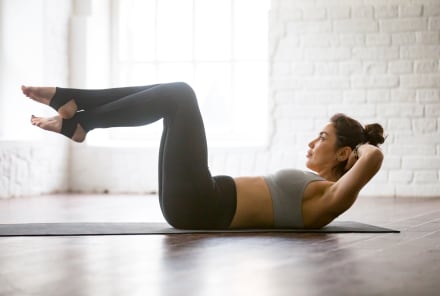Advertisement
What Does It Actually Mean To Engage Your Core? Experts Explain


Anyone who has taken a Pilates, yoga, or barre class has most likely heard the phrase "engage your core." The action has a variety of supportive and physical benefits, but what exactly does it mean, and how do you know if you're doing it properly?
We consulted personal trainers and fitness experts to help answer these questions before your next workout.
What does it mean to activate or engage your core?
The word "core" makes most people think of abs, but the core actually encompasses far more than just one region of the body.
"When we talk about your core, think of it as a group of muscles that stabilize your spine," says fitness trainer BB Arrington, NASM-CPT. This includes the back, abs, glutes, pelvic floor muscles, and even the diaphragm (muscle of respiration).
More specifically, your "multifidus, erector spinae, rectus abdominis, transverse abdominis, obliques, and pelvic floor" play a large role, she says, "and to a lesser degree, your latissimus dorsi, trapezius, and glutes."
Activating or engaging the core means you're tightening all of those muscles at once.
What are the benefits of engaging your core?
Engaging your core is important while working out but also during everyday activities. Personal trainer and meditation teacher Jason Williams, NASM-CPT, says it helps to maintain healthy posture, prevent injuries in the lower back, and improve coordination and balance.
When working out, engaging your core helps you to move more efficiently, increase your strength, and can take pressure (load) off of the spine, Arrington says. "When it comes to your life outside the gym, engage when there is a challenge to be met, like picking up your child or putting your suitcase in the overhead bin," she says. Doing so "helps you become more stable and gives the spine support."
That said, walking around with your core engaged 24/7 is not necessary. In fact, walking around with your “core pulled in” all the time, can lead to overworking of the muscles and other issues.
How do you know if you're doing it properly?
Understanding what it means to engage your core and actually knowing how to do it are totally different. So, what does it feel like?
"When the core is properly engaged, you'll feel a lift in the center of the body," Williams says. "It will feel like an elongation in the spine." He says to think about stretching from the pelvis all the way to the top of the head.
After the lift comes a zip and then a tightening, Arrington says. "When it comes to the sensation, your belly button will draw a bit closer to your spine, the pelvic floor will lift upward toward the crown of your head," she says. "Your trunk will feel more rigid, and you'll feel the pressure change internally as your muscles tighten." It's not just sucking in the belly.
Breathing can also play a critical role in engaging the core. A focus on inhaling, exhaling, and regulating the breath can help muscle fatigue and performance, Williams explains. Try these five core-strengthening exercises to put your new knowledge to the test.

Short On Time? Try This Personal Trainer's 5-Minute Full-Body Workout
Krista Stryker, NSCA-CPT

Short On Time? Try This Personal Trainer's 5-Minute Full-Body Workout
Krista Stryker, NSCA-CPT

Short On Time? Try This Personal Trainer's 5-Minute Full-Body Workout
Krista Stryker, NSCA-CPT

Short On Time? Try This Personal Trainer's 5-Minute Full-Body Workout
Krista Stryker, NSCA-CPT









